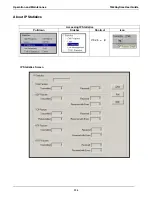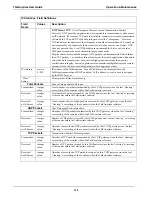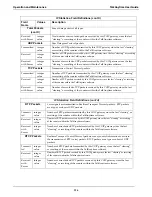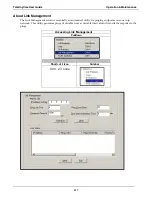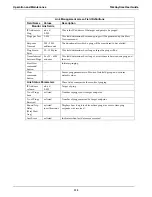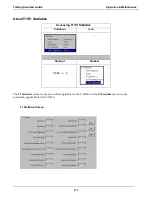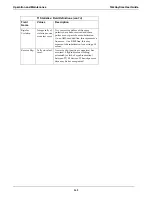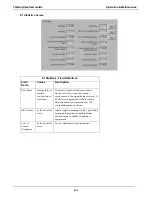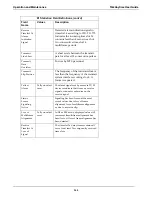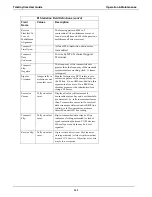
Operation and Maintenance
TalkAnytime User Guide
150
Call Progress Details: Field Definitions (cont’d)
DTMF/Other Details
Field Name
Values
Description
Prefix Matched
specified dialing
digits
Displays the dialed digits that were matched to a phonebook entry.
Outbound Digits
Sent
0-9, #, *
The digits transmitted by the
TalkAnytime
to the PBX/telco for
this call.
Outbound Digits
Received
0-9, #, *
Of the digits transmitted by the
TalkAnytime
to the PBX/telco for
this call, these are the digits that were confirmed as being received.
Server Details
n.n.n.n
(for n=0-255)
and/or other
server IP-related
descriptions
The IP address (etc.) of the traffic control server (if any) being used
(whether an H.323 gatekeeper, a SIP proxy, or an SPP registrar
gateway) will be displayed here if the call is handled through that
server.
Not applicable for TalkAnytime units.
DTMF Capability
inband,
out of band
Expressions differ
slightly for
different Call
Signaling
protocols (H.323,
SIP, or SPP).
Indicates whether the DTMF dialing digits are carried "Inband" or
"Out of Band." The corresponding field values differ for the 3
different voip protocols.
For H.323, this field can display "Out of Band" or "Inband". For SIP
it can display either "Out of Band RFC2833" or "Out of Band SIP
INFO" to indicate the out-of-band condition or "Inband" to indicate
the in-band condition. For SPP it can display "Out of Band
RFC2833" or "Inband".
Supplementary Services Status
These fields are not applicable to TalkAnytime.
Call Status
fields
Call Status
hangup, active
Shows condition of current call.
Call Control
Status
Tun, FS + Tun,
AE, Mux
Displays the H.323 version 4 features in use for the selected call.
These include tunneling (Tun), Fast Start with tunneling (FS +
Tun), Annex E multiplexed UDP call signaling transport (AE), and
Q.931 Multiplexing (Mux). See
Phonebook Configuration
Parameters
(in T1 or E1 chapters) for more on H.323v4 features.
Silence
Compression
SC
“SC” stands for Silence Compression. With
Silence Compression
enabled, the TalkAnytime will not transmit voice packets when
silence is detected, thereby reducing the amount of network
bandwidth that is being used by the voice channel.
Forward Error
Correction
FEC
“FEC” stands for Forward Error Correction.
Forward Error
Correction
enables some of the voice packets that were corrupted
or lost to be recovered. FEC adds an additional 50% overhead to
the total network bandwidth consumed by the voice channel.
Default = Off
Summary of Contents for TalkAnytime TA2410
Page 6: ...6 Chapter 1 Overview ...
Page 20: ...20 Chapter 2 Quick Start Instructions ...
Page 48: ...48 Chapter 3 Mechanical Installation and Cabling ...
Page 56: ...56 Chapter 4 Software Installation ...
Page 65: ...65 Chapter 5 Technical Configuration ...
Page 116: ...Technical Configuration TalkAnytime User Guide 116 ...
Page 123: ...123 Chapter 6 Phonebook and URL Configuration ...
Page 143: ...143 ...
Page 144: ...144 Chapter 7 Operation and Maintenance ...
Page 205: ...205 Chapter 8 Warranty Service and Tech Support ...
Page 208: ...208 Chapter 9 Regulatory Information ...
Page 213: ...213 Appendix A Cable Pinouts ...
Page 217: ...217 Appendix B TCP UDP Port Assignments ...
Page 219: ...219 Appendix C Expansion Card Installation TA24 48 TA30 60 ...
Page 234: ......
Page 235: ...235 S000424A ...



















